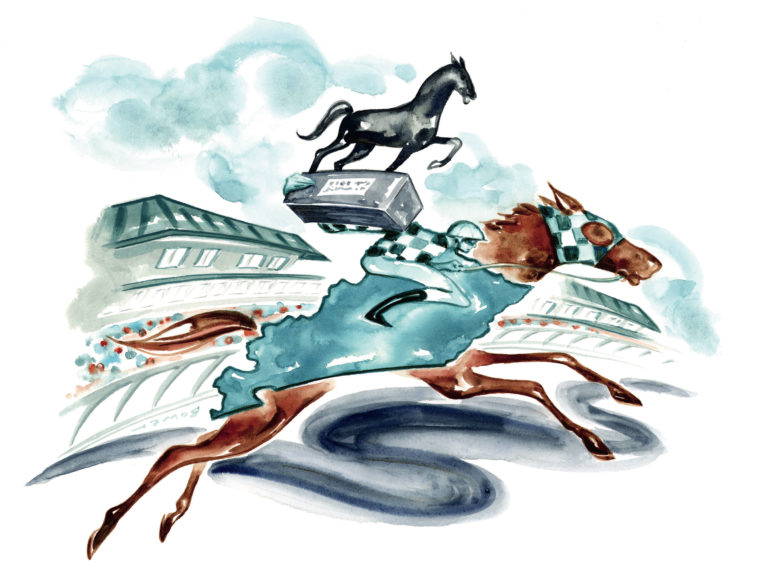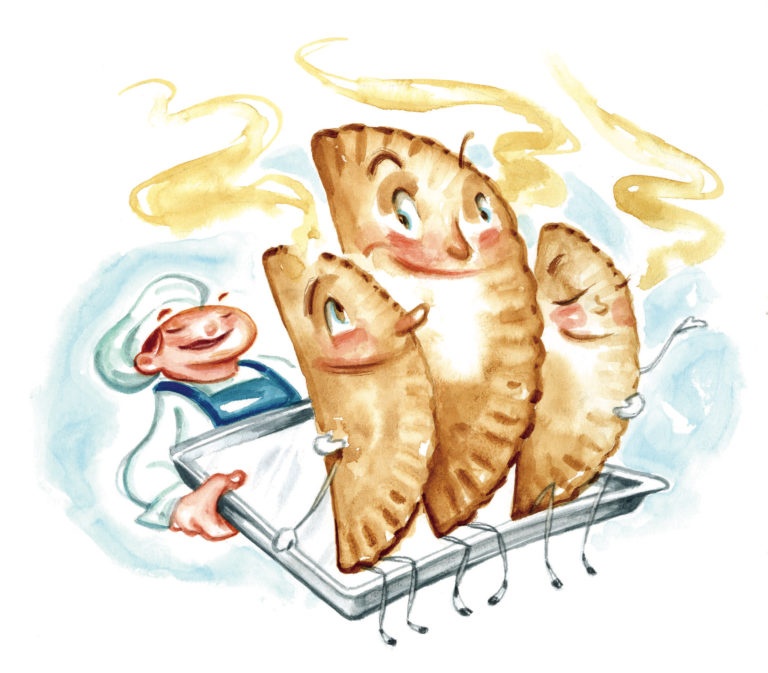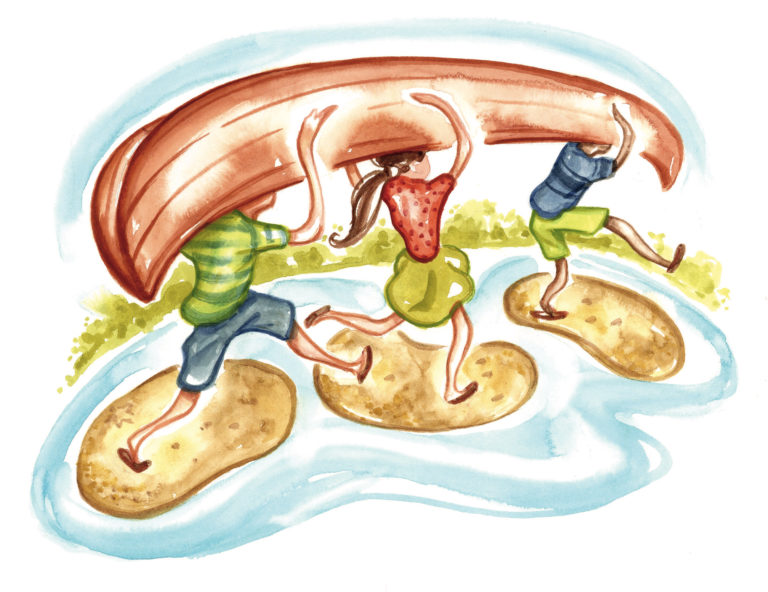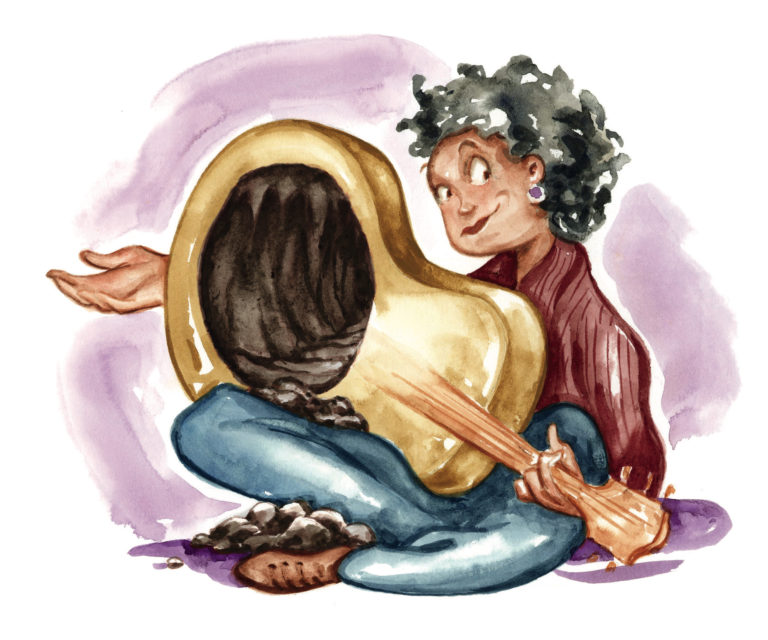Front and Center
During Porch Fest (November 19) in historic little Brewton, local and regional bands play from porches fronting thirty of the town’s oldest, grandest, or most charming homes, many built in the mid-1800s for its founding timber barons. Country musicians croon among Corinthian columns, bluegrass pluckers perform behind slender turned balustrades, and rock rolls over Craftsman bungalows’ brick steps. The event celebrates Brewton’s musical heritage—the Oak Ridge Boys’ William Lee Golden (who played last year) is a native son—as well as its well-preserved structures. The entire downtown is on the National Register of Historic Places, including Alabama’s oldest bank, with a lacelike white-tile facade. “Most of the porches look straight out of a magazine, but I like that some smaller stoops are stages too,” says the local musician Shannon Brantley. “It’s a giant block party.” The daylong concert series culminates at the striking, wedding cake–esque curved portico of the 1903 Downing House, where listeners catch the show from the comfort of their lawn chairs. cityofbrewton.org
Let the Chips Fall
Legend has it that Arkansas’s love affair with gooey, peppery melted cheese dip dates back to 1935, when Blackie Donnelly and his wife, Margie, concocted a spicy recipe for dippable cheese at their Mexico Chiquito restaurant, then in Hot Springs. Plenty of riffs followed over the years, as well as homages, including In Queso Fever: A Movie about Cheese Dip, a 2009 documentary by the Arkansas native Nick Rogers that spurred the creation of downtown Little Rock’s annual World Cheese Dip Championship (October 30). In professional and amateur divisions, restaurateurs and home cooks whip up their closely guarded versions—most with a base of Velveeta and Ro-Tel, some heavy on the veggies, others flavored with beef, chicken, or bacon. Each ticket holder gets a bag of chips and a voting token. “Last year, I took three five-gallon buckets of cheese dip and I left with none,” says Dominique Greer, the general manager of Dizzy’s Gypsy Bistro, the Little Rock spot that claimed the top prize last year (and a few years before that, too). “I won’t give away any secrets, but ours utilizes a grill, has a lot of different peppers in it, and is the perfect consistency to coat a chip.” cheesedip.net
World’s Fair of Flats
Whether you want to learn how to tighten your fly-line loops when casting to cruising bonefish, tarpon, or permit, or dive deep into the cutting-edge science of saltwater flats conservation (or better yet, both!), set a course for the PGA National Resort in Palm Beach Gardens for November 4 and 5. The Florida-based Bonefish & Tarpon Trust will hold its seventh International Science Symposium & Flats Expo, a hip mash-up of research and recreation with presentations on the latest studies of flats species and habitats, clinics on fly tying and casting, an art and film festival, and an exposition packed with the latest gear. “This event only rolls around once every three years, and there’s nothing else like it,” says Jim McDuffie, the Trust’s CEO. “We gather an amazing roster of living angling legends, the best boat and gear makers on the planet, and the scientists who are leading the charge on the conservation of saltwater flats and mangroves the world over.” This year BTT will induct into its Circle of Honor some of the most recognized names in saltwater fly fishing and conservation: Chico Fernandez, Sandy Moret, Matt Connolly, and Andy Danylchuk. bonefishtarpontrust.org
Unbridled History
Last year, when Donovan Johnson, the executive director of the Bill Lowe Gallery in Atlanta, visited the studio of Georgia artist Todd Murphy, who had died in 2020, to discuss hosting a retrospective on the visionary’s career, one work stopped him in his tracks: a digital painting of the National Museum of Racing’s Hall of Fame jockey Jimmy Winkfield and his horse, Murphy’s nod to the heroic achievements of Black jockeys. That painting and more than thirty other never-before-seen sculptures, found objects, and digital paintings became Wink, an exhibition examining the history and legacy of Black jockeys in America, opening at the gallery on October 7. Along one wall, a peplum dress billows over a film projection of a race, reminiscent of the 2.11-second-long 1878 film of a Black jockey riding a galloping steed, widely considered the first film ever made. “Todd had the ability to synthesize the zeitgeist in a unique way,” Johnson says. “It’s redemptive and beautiful.” lowegallery.com

Breeders’ Cup Returns to the Bluegrass
In 1982, Lexington horseman John Gaines proposed a season-ending event to bring together the world’s top Thoroughbreds for a day of championship racing. “Just like the NFL has its Super Bowl and Major League Baseball has the World Series, our founders believed that our sport needed a championship of its own,” says Breeders’ Cup CEO Drew Fleming. The first Breeders’ Cup World Championships took place in 1984 at California’s Hollywood Park, and nowadays the last race of the weekend—the Breeders’ Cup Classic—is considered a fourth leg of the Grand Slam of Thoroughbred racing after the Kentucky Derby, Preakness Stakes, and Belmont Stakes. Lexington didn’t host its first Breeders’ Cup until 2015, the year Triple Crown winner American Pharoah went wire to wire in the Classic and captured the elusive Grand Slam. The event again ran at Lexington’s Keeneland Race Course in 2020 but without spectators due to the pandemic. The Breeders’ Cup returns to Keeneland November 4 and 5, this time with fans in attendance and a concurrent festival highlighting Lexington’s foundational role in the sport. “Central Kentucky is the home of Thoroughbred racing, and we want to showcase that to the world,” Fleming says. “It’s also a great excuse to dress up, pour a glass of Champagne, and enjoy a spectacular week of the equestrian lifestyle.” breederscup.com

Rolling in Dough
It’s not easy to make eight hundred pies in one day, but Nancy Brewer can do it. The owner of the Kitchen Shop bakery in the small St. Landry Parish town of Grand Coteau, Brewer knows a thing or two about pie baking. And she knows more about sweet dough pie baking than pretty much anyone on earth. The regional Cajun treat is folded like a hand pie but has a thicker, softer, and sweeter crust than ordinary pies; popular fillings include custard, fig, lemon, blackberry, and Louisiana sweet potatoes. Grand Coteau calls itself the Sweet Dough Pie Capital of the World, and every fall, the town fittingly throws a Sweet Dough Pie Festival; this year (October 29), just like last year, Brewer will serve the special treats from her bakery. “People from across the state don’t even know about sweet-dough pies,” Brewer says. “But the festival sure is super popular.” cajuntravel.com
The Ultimate Rail Trail
Autumn excursions on the Western Maryland Scenic Railroad not only showcase Appalachian fall color, but they also set up adventure seekers for a breezy downhill ride. The Cumberland-to-Frostburg rail line can haul a dozen bicycles on its roughly fifteen-mile run up and along Piney Mountain. At the top of the route in Frostburg, cyclists join a section of the Great Allegheny Passage, a rail trail paralleling the railroad back to Cumberland. The path is almost entirely coastable, with shaded downhill slopes, easy pedaling through tunnels, and striking Allegheny mountain views from across a century-old truss bridge. (Heading in the other direction, the trail leads all the way to Pittsburgh.) A newly restored steam locomotive, No. 1309, might just be chugging down the mountain, too. Mothballed in 1956, the train reentered service last year, and like all engines, the massive marvel has its own personality. “Engines are constantly telling you what they like or don’t like,” says Wesley Heinz, the railroad’s executive director. “They have a heartbeat. They speak to you. They sigh.” wmsr.com

Sandbar Season
The Mississippi River is an impressive sight year-round, but hospitable weather and the usually lower water levels make fall the perfect season for discovering the secret life of the sandbar. Some barren, some sylvan, some miles in length, the Mississippi’s no-name islets might be here one year, gone the next. “We’re basically island-hopping,” says professional riverman Matthew Burdine of his canoe expeditions, which guide explorers—from solo campers to bluegrass bands to supper clubs—to these ephemeral shores. The mission: Soaking up all the secluded natural wonder, sunbathing, and fossil hunting they afford. Barge traffic, fierce currents, and debris, among other hazards, can spell danger for inexperienced boaters, but John Ruskey at Quapaw Canoe Company out of Clarksdale and his partner Burdine at their new Mississippi River Expeditions out of Memphis run expert-led trips all year long. Even first-time paddlers will hit their stride in custom-made, hard-to-flip, thirty-foot-long craft fit for transporting small groups—along with every possible party supply. canoememphis.com; island63.com
Farm Girl to Femme Fatale
When Ava Gardner moved to Hollywood in the 1940s, stardom was her wildest dream. “She came from very simple beginnings and became one of the most famous people in the world,” says Lynell Seabold, the executive director of the Ava Gardner Museum in downtown Smithfield. Born into a family of seven children in a farmhouse in rural Johnston County, Gardner eventually rose to international fame for her leading roles in blockbusters such as The Killers, The Night of the Iguana, and The Barefoot Contessa. She also married three of the most iconic celebrities of the day: Mickey Rooney, Artie Shaw, and Frank Sinatra. The museum’s highlights include her costumes—the yellow corseted frock from My Forbidden Past, for instance, and the one-shouldered black Vera West gown from The Killers. This year’s Ava Gardner Festival (October 7–9) at the museum celebrates the hundredth anniversary of her birth with film showings, the dedication of a mural and rose garden, and a musical tribute with songs from Gardner’s personal record collection. johnstoncountync.org/ava-gardner
Lowcountry Legacies
In 1981, when the Penn Center’s Heritage Days began on St. Helena Island, the event consisted of a one-day celebration of Gullah Geechee history and culture. People loved it so much, recalls St. Helena native and cochair of the planning committee Marie Gibbs, organizers had to make it three times longer. This November 10–12, festivities will sprawl across the center’s fifty-acre campus—site of the South’s first school for people freed from slavery. “Our history is a legacy we’re preserving and protecting,” Gibbs says of the Gullah Geechee community. “Here we bring it back out and let you actually see what happened during that time, with music, storytelling, singing, dancing…” That list goes on: fish fry, Lowcountry supper, basketmaking, art, theater, a Saturday morning parade, and a worship service with old-time spirituals and call-and-response prayer Thursday night at the Brick Baptist Church. Don’t miss the chance to imagine that space in 1862, when the Penn School’s inaugural class of eighty pupils congregated for the first time. penncenter.com/heritage-days

Cave Dwellers
“Going into a cave is timeless, and listening to music there is a surreal experience,” says Todd Mayo, the founder and operator of the Caverns, a subterranean live-music venue in Pelham, about an hour northwest of Chattanooga. Mayo broadcasts PBS’s Emmy-winning Bluegrass Underground from the Caverns, and the spot even won G&G’s Favorite Southern Music Venue Bracket earlier this year. On October 8 and 9, the Caverns will host its inaugural CaveFest, with shows both underground and in the recently added surface-level amphitheater. “For this first CaveFest, we are going back to our bluegrass roots,” Mayo says; headliners include Sam Bush, the Infamous Stringdusters, Leftover Salmon, Rising Appalachia, Yonder Mountain String Band, and surprise collaborations with the festival’s artist in residence, Lindsay Lou. “We will have some late jams in the cave going deep into the night,” Mayo promises. “And look out for Travis Stinson of the Volunteer String Band—he has one of the most amazing voices in bluegrass.” thecaverns.com
Outside the Box
From the 1950s through 1979, a Houston postal worker named Jeff McKissack collected scraps of metal, bricks, gears, mannequins, statues, and rogue tractor parts and then used them to erect a mazelike three-thousand-square-foot monument dedicated to his favorite fruit. “The Orange Show Monument is a performance venue inside a massive whirligig wonder wheel,” says Tommy Ralph Pace, the executive director of the Orange Show Center for Visionary Art (OSCVA), the foundation that protects and promotes this site and other outsider artworks in Houston. Through exhibits, performances, classes, public art installations, and an annual springtime parade of decorated cars, “we’re poking at the notion of who is an artist,” Pace says. This fall, OSCVA caps off its fortieth year with a workshop, exhibit, and performance by the Alabama found-object artist Lonnie Holley, and a show by the Mississippi Hill Country Blues players R. L. Boyce and Lightnin’ Malcolm. orangeshow.org
Love Shrine
These days, lovestruck couples rely on sports arena jumbotrons or skywriters to publicly spell out their affection in pixels or puffs of airplane exhaust. But at the turn of the twentieth century, James H. Dooley, a Virginia businessman and the owner of Maymont, Richmond’s Gilded Age estate turned park, chose to honor his wife, Sarah “Sallie” May, with the construction of what is still the largest Tiffany glass window in a private home in America. When the couple built their summer abode, Swannanoa, a Blue Ridge Mountain Italianate marble manor, he ordered a four-thousand-piece, twelve-by-twelve-foot testament to their love, with her image glowing at its center. “I always tell grooms having weddings here, ‘Mr. Dooley built all this for his wife; you’re going to have to step it up!’” says Adrianne Boyer, a director at the private property, which is also decked out with oak parquet flooring, coffered ceilings, and cherubic frescoes. Swannanoa sat abandoned and exposed to the elements during the Great Depression, but it’s still remarkably intact, with scheduled dates for public visits running through late fall. skyline-swannanoa-inc.square.site
Folk Heroes
“The artists in We Are Made of Stories: Self-Taught Artists in the Robson Family Collection followed their own stars and shaped artistic practices that suited their needs in a particular time and place,” says Leslie Umberger, a curator at the Smithsonian American Art Museum, which recently opened the powerful exhibition of self-taught artists’ work (it runs through March 26, 2023). “Some used art as a means of bearing witness, others for asserting presence and identity,” she says. “Some used art as a language that transcended the verbal.” The exhibition traces the rise of forty-three artists in the twentieth century—close to half of them from the South, including Alabama’s Bill Traylor, who drew graphic silhouettes on paperboard, and South Carolina’s Sam Doyle, who painted scenes of St. Helena Island life on tin siding. While most of the artists have been recognized in museums, several remain largely unknown, their art an uncredited tribute to the creative human spirit. americanart.si.edu
Glass Act
Last February, when a water pipe burst in the Oglebay Institute Glass Museum in Wheeling, flooding the display cases of chalices, vases, and the famous five-foot-tall, sixteen-gallon Sweeney punch bowl, curators looked at the situation as goblet half full. “We used it as an opportunity to do a thirty-year makeover,” says Holly McCluskey, the institute’s curator of glass, who, with her team, cleaned and inventoried all four thousand pieces of locally made glass on display. In the nineteenth century, Wheeling became a glassmaking powerhouse thanks to a fortuitous intersection of resources: sand from the Ohio River and a natural abundance of limestone; a bounty of cheap fuel sources including coal and natural gas; and an influx of travelers passing through on steamboats, railroads, and the first federally funded road. Fifty percent of all pressed glass used in the country at the time came from this area. On November 7, the museum will reopen to the public with upgraded jet-black display cases and jewelry-store lighting to enhance the viewing experience, as well as a more thorough look at the hands behind the heirlooms. “We’re focusing on the process, the product, and the people,” McCluskey says. “For one piece of glass, there were as many as thirty workers involved in making it.” oionline.com


